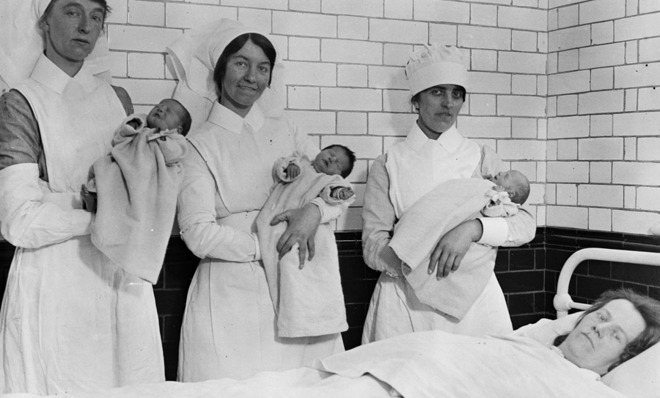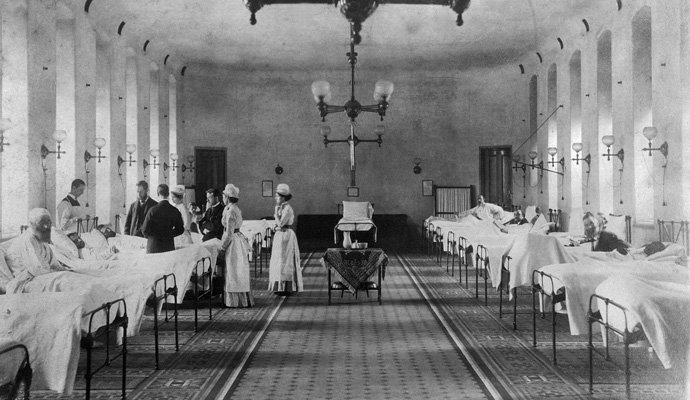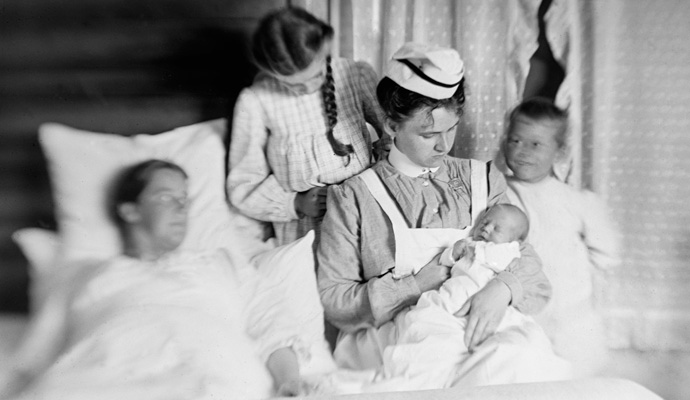How to give birth (100 years ago)
Don't forget to stock up on the Lysol and the leeches


Up until the mid-19th century, childbirth was something men avoided. Women had babies in a room full of other women, aided by female midwives and nurses. Then the profession of "doctor" began to mean more than "guy who waves burning sage over your head while draining your blood." Science entered the practice of medicine, and it became a respectable profession that was almost exclusively the domain of men.
Male doctors wanted everyone to know that their knowledge and abilities were far superior to that of a common grubby midwife. So they began writing books. They took childbirth out of the intuitive hands of midwives, and claimed it as their own.
Most of what they wrote was as scientifically sound as could be expected for the era. Still, some of it was egregiously puzzling. Here, we look at some of the stranger advice of the day.
The Week
Escape your echo chamber. Get the facts behind the news, plus analysis from multiple perspectives.

Sign up for The Week's Free Newsletters
From our morning news briefing to a weekly Good News Newsletter, get the best of The Week delivered directly to your inbox.
From our morning news briefing to a weekly Good News Newsletter, get the best of The Week delivered directly to your inbox.
Preparing for the birth

In the mid-1800s, many women went to the "lying-in" hospital to be attended by physicians for childbirth. (This practice often proved fatal, as doctors who had no concept of sterilization or contagion would transmit diseases from woman to woman with their own bare hands). But if a woman lived rurally or had enough money, she delivered in her own home. Preparing the birth-room was an important part of childbirth. Turn-of-the-century plumbing, for instance, was an evil in need of a good spackling, according to Henry Davidson Fry's 1907 book, Maternity:
Sewer gas in the room is dangerous; for that reason a communicating bathroom is objectionable. In such a case the communicating door should be locked and the key removed. For the same reason stationary washstands are undesirable. The outflow openings should be closed with plaster of paris. [Fry]
Preparing the patient herself was also important. Fry's desire that the patient be sterilized was admirable, albeit rather abrasive.
The nurse should give particular attention to cleansing and preparing the skin of the abdomen, thighs, and external genital parts. First scrub with warm sterile water and soap, then rub dry, and afterward bathe the parts in a bichloride solution 1-1000, or solution of Lysol, one percent. It is particularly difficult to render the external parts surgically clean. The hair around the genitalia should be cut short with scissors or shaved, scrubbed with hot sterile water, and bathed with bichloride solution. [Fry]
Shaved, scalded, and sprayed down with Lysol. Now you're ready for some real discomfort.
A free daily email with the biggest news stories of the day – and the best features from TheWeek.com
However, John Gunn's 1861 Gunn's New Domestic Physician had a gentler suggestion for preparing those sensitive areas for the task ahead:
The parts of generation during labor should always be well oiled or greased with lard, as it greatly assists and mitigates the suffering, and lubricates the parts of passage. [Gunn]
Candles, cooking, refurbishing, and greasing up the birth canal. What can't lard do?
Women today usually choose to give birth in as few clothes as their modesty (such as it is in childbirth) allows. In his 1907 book, Coming Motherhood, Louis A. Spaeth shows us that women 100 years ago felt the same way. Unfortunately, the popular sports bra and knee socks combination was apparently not an option back then.
Probably the best way to dress a woman for the lying-in-bed is in short undershirt or under vest, shirt waist (blouse) and a skirt or petticoat, warm stockings and bed-room slippers. The supreme advantage of this method of dressing lies in the fact of the easy removal of the soiled garments. When labor is over, the skirt or petticoat is removed over the feet, the shirt waist taken off, and a clean night gown put on. [Spaeth]
Just because you're pushing a bloody human being from your vagina doesn't mean you get to dress like a slob, Madam. Show some decorum and be grateful Mr. Spaeth doesn't recommend returning to corsets until after the birth is over.
Pain mitigation

A few decades make a world of difference in the popular methods of handling the pain of birth. Dr. Gunn's method is as natural and low-impact as his suggested use of lard. Just get yourself a nice towel.
A towel, sheet, or some convenient article, should be tied to the bed post, so that at each pain the woman may pull it, as it assists her very much in her efforts, and she derives great benefit and comfort from the support. [Gunn]
It was long believed that pain was supposed to be part of childbirth, and to try and cheat it was to cheat God. Fry tells of a story wherein a poor woman in 1591 was burnt to death in Edinburgh "for employing charms and other means to cast off the pains of labor." Fry explains why pain mitigation was unpopular for most of history.
The arguments against it were:
The relief of pain during childbirth removed the maternal instinct.
It was immoral because it produced a condition similar to intoxication.
Various ill effects were attributed to it — epilepsy, convulsions, and insanity.
The most powerful argument against the relief of pain was that it was sacrilegious to thrust aside the decrees of Providence. Woman had been sentenced to suffer the pangs of childbirth, and it would rob God of the deep, earnest cries which arise in time of trouble for help. [Fry]
It is amazing how attitudes toward childbirth can change, however, when the most powerful woman in the world has eight children. In 1853, Queen Victoria was chloroformed during the birth of Prince Leopold, and a new era of pain control was born. One Sir James Y. Simpson even helped convince the religious-minded that perhaps God did not insist on suffering in birth.
Says Fry:
The Scottish clergy reviled Simpson for his work in opposition to the primeval curse, "In sorrow shalt thou bring forth children." He turned their shaft to ridicule by reminding them that the first operation recorded in history was performed under anesthesia, since when God created Eve from one of Adam's ribs, he "caused a deep sleep to fall upon Adam." [Fry]
Good enough for God, good enough for the Queen, good enough for you.
Of course there will always be women who prefer natural pain control to chemical. In 1907, Spaeth had a unique approach to dulling labor pains. Apparently, the nerves of the womb are directly connected to the clitoris. Ergo sum:
With our present knowledge of the nerve supply of the womb, we are enabled to lessen the pains of labor to a very marked degree. During the first stages, pressure is made with the fingers on the terminal filaments of the sympathetic nerves in and around the clitoris. The index and middle fingers are placed, one on each side of this organ, and firm, moderately hard pressure is made against the bone with the direction of the pressure upward toward the abdomen; this is done by the attending physician, the nurse, or by the woman herself. A reflex result occurs, in which contraction of the womb follows; its mouth dilates, normal propulsion pains ensue, and labor proceeds naturally, all unnecessary flying pains cease. [Spaeth]
I cannot speak against this method, as even though I have had two children, I have never tried it. And likely would have punched anyone who suggested I should.
Post-partum instructions

In 1835, postpartum care mostly involved holding very, very still for a ridiculously long time. After childbirth, women are particularly fragile in mind and body, and physicians where terrified important things would fall out of a lady if she jostled around too much. In his book The Home Book of Health and Medicine, William Edmonds Horner lays it out:
Rest and quiet should be strictly enforced; no visitors should be admitted for a fortnight or three weeks, both to secure the mother from fatiguing herself by talking, and from hearing anything that might agitate or distress her mind. [Horner]
In 1896's Preparation for Motherhood, Elisabeth Robinson Scovil agrees. Even if the new mother wants to talk, she's not allowed to.
After all that the newly made mother has undergone, she needs perfect quiet for several hours before she is permitted to see anyone. A five-minute interview with her husband is all that should be granted. However well she feels, quiet should be insisted upon. Excitement is dangerous and no visitors must be permitted to enter the room, nor should conversation be allowed, even if she wishes to talk. Neglect of this precaution may cause serious disaster, even when all seems to be going on well. [Scovil]
Fry details the amount of interaction and movement the mother is allowed in excruciating detail.
For the first two hours after labor the patient should lie upon her back with the lower limbs extended and her head low. She can then be changed to the side position when desired, but for the first four days she ought to lie upon her back most of the time. After the fourth day she should change to the side often, and it is desirable to lie upon the abdomen some. After the fifth or sixth day she may be propped up in bed with pillows behind her for one-half or one hour at a time. She should not sit up in a chair until the top of the womb has descended into the pelvic cavity — from the tenth to the fourteenth day. The first day that she sits up she should remain out of bed only one hour and must not stand upon her feet or walk until the middle or end of the third week. On the second day that she gets out of bed she can stay up one hour in the morning and one in the afternoon or evening. The length of time is gradually increased, but even during the third or fourth weeks she should lie down or recline upon a sofa much of the time. She should not get up early in the mornings, but have her bath, breakfast, and a rest before doing so. She should wear a wrapper and not go through unnecessary fatigue of dressing.
She should not go down stairs until the end of the fourth week, and then only once a day for the first three days. After that she can go down morning or noon and evening. At the end of the fifth week she can go out for a short walk or drive. Shopping and visiting should be avoided for some time longer.
Neglect of these precautions often causes backache, subinvolution, and displacement of the womb. [Fry]
Fry must have been writing for a very elite group of women who had the luxury of lying around all day. Today, we live in a world where pre-made clothes wash themselves in large whirring boxes, and meals come prepackaged in plates you can throw away, and I still don't know any woman who can spend six weeks not moving. One-hundred-fifty years ago, if the average farmwife took to her bed for that length of time, her family would starve, her animals would turn feral, and the dark forest would reclaim her homestead. Still, it's a lovely thought.
Aside from stillness, there are other precautions to consider. For instance, if you find your generative organs have been unduly tormented by the act of childbirth, Horner suggests milk and bread. Or leeches.
Great stretching of the parts. This occasions great soreness, and uneasy feelings, which are best removed by bathing with warm milk and water. If there be much swelling, an emollient poultice of bread and milk, or linseed meal, may be applied, and frequently renewed. If there be general uneasiness, with heat and throbbing pain in the part, leeches may be necessary. [Horner]
As for the rest of your general post-partum health, one of the worst things you can do, according to Horner, is to eat and drink. Which may not be all that bad, considering you're not allowed to move.
The diet of women, after delivery, should be particularly attended to. For the first five or six days, all heating and stimulant food, and in general all solid and animal food whatever, should be forbidden, as such diet is very apt to bring on inflammatory complaints.
If the woman is not to nurse, she should avoid liquids as much as possible, and rather take a little fruit, ripe or preserved, to quench the thirst. If she is to nurse, she may have a little tea and panado, or gruel for breakfast, and, after a few days have elapsed, a little weak chicken broth or beef-tea, with toasted bread, for dinner; but wines and malt liquors should be avoided. [Horner]
If you're not going to breastfeed, you haven't earned the right to eat your gruel. But you can have malt liquor.
Today, childbirth is slowly returning to the domain of the female attendant, with female doulas, midwives, nurse midwives, and obstetricians slowly outpacing their male counterparts. It is possible that the time in which men were the prime authorities on childbirth will prove to be but a small blip in history. Because, after all, women were made for it. Put humbly by Gunn:
That Women generally endure pain and sickness with more fortitude and patience than men, is evident. Looking forward with the pleasing hope of being the mother of a tender offspring, upon which she can lavish her affection and tenderness, sustains her in fulfilling the conditional requirements of Nature. Few men could be induced, for any consideration, to suffer in a similar manner. [Gunn]
Therese O'Neill lives in Oregon and writes for The Atlantic, Mental Floss, Jezebel, and more. She is the author of New York Times bestseller Unmentionable: The Victorian Ladies Guide to Sex, Marriage and Manners. Meet her at writerthereseoneill.com.
-
 US citizens are carrying passports amid ICE fears
US citizens are carrying passports amid ICE fearsThe Explainer ‘You do what you have to do to avoid problems,’ one person told The Guardian
-
 All roads to Ukraine-Russia peace run through Donetsk
All roads to Ukraine-Russia peace run through DonetskIN THE SPOTLIGHT Volodymyr Zelenskyy is floating a major concession on one of the thorniest issues in the complex negotiations between Ukraine and Russia
-
 Why is Trump killing off clean energy?
Why is Trump killing off clean energy?Today's Big Question The president halts offshore wind farm construction
